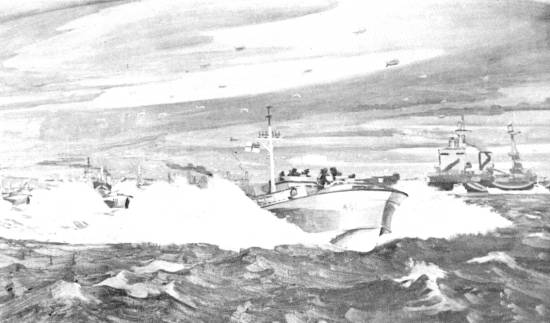THE RCN ON D-DAY
Page 3: The MTBs
Originally
published in the "Crowsnest Magazine" Vol. 16 No. 5 May
1964
By Lt. Peter Ward, RCNR
|
|
|
|
|
ANY ACCOUNT of the invasion of Europe and the part played in it by Canadian forces must surely include mention of the Canadian-manned motor torpedo boat flotillas. There were two such flotillas: the 29th, armed with “shorts”, 71+ feet in length and with a top speed of 38 knots, and the 65th, composed of “D” class Fairmiles, slower, longer and more heavily armed than the “shorts”.
The two flotillas of RCN motor torpedo boats joined the 10th Flotilla’s campaign against enemy surface ships in the channel about mid-May. The 29th and 65th MTB Flotillas were organized in mid-March, but took a month to bring themselves to fighting pitch. Four boats of the 29th drew the first duty. They were assigned to proceed to the D-Day beaches with two British MTBs, and protect them while volunteers were landed by outboards to lift sample mines from beach defence. They managed to complete their mission undetected and returned with the German mines. What they learned by dismantling of these mines enabled our troops to avoid considerable casualties when D-Day came.
May 2 saw boats of both the 29th and the 65th out in force. Both flotillas had good hunting and they each badly shot up an enemy convoy.
These
tiny, fast MTBs combined with the Tribals to put many enemy warships
out of action before the Channel became clogged with tempting targets
on June 6.
They
fought all up and down the Channel, intercepting enemy coastal convoys,
duelling with German E-boats, luring German destroyers within the
gun range of heavier warships, shooting up escort ships and torpedoing
merchant vessels.
Their work carried on into 1945, by which time their field of action had extended along the English Channel into the North Sea. The 29th Flotilla was practically wiped out by a disastrous fire at Ostend in February 1945, but the 65th continued its patrols until the end of the war in Europe.
>>> Go to Next Page
 |
|
Canadian
MTBs helped protect the huge fleet from German E-boatrs. Cdr.
Tony law painted the boats of his flottilla moving at speed
on the finges of the shipping. (O-5357)
|
